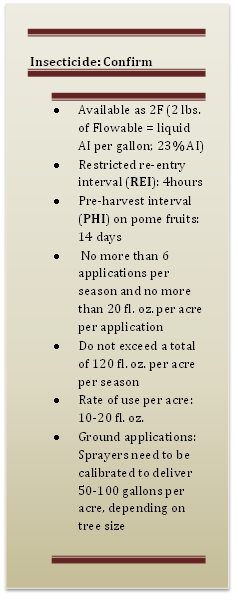Reduced Risk Insecticide: Confirm
This summer, the Fruit Crop Entomology lab will review selected insects and insecticides. We hope you enjoy them! Here’s our first installment.

Confirm 2F, which is registered for Wisconsin tree fruits apple, crabapple, pear and quince,is not a new insecticide. It has been registered for these fruits since the late 1990’s. It is marketed by Gowan Company under the formulation 2F (2 lbs of active ingredient per gallon, Flowable). Confirm is an Insect Growth Regulator (IGR) with the active ingredient tebufenozide. It mimics the action of a natural insect hormone (20-hydroxyecdysone) that induces molting and metamorphosis in insects. It is highly active against most lepidopterous larvae by inducing premature lethal molt after ingestion from treated crop surfaces. Larvae may take several days to die, but feeding generally ceases within 24 hrs. of ingestion.
Confirm 2F is registered for control of codling moth, obliquebanded and other leafrollers, lesser appleworm, green and laconobia fruitworms, tufted apple bud moth, and eyespotted bud moth. For codling moth, Confirm 2F can be applied at a rate of 20 fl. oz. per acre. Your first application should take place at egg hatch (150-250 degree days (base 50°F) accumulated following sustained adult trap catch), and a second application should be applied 10-15 days later.
Confirm 2F may be applied by ground equipment or by air (see label for specific application regulations). For ground applications, conventional ground sprayers need to be calibrated to deliver a minimum of 50 gallons per acre to trees that are less than 10-feet tall, or which are trellised, and calibrated to deliver a minimum 100 gallons per acre to trees that are greater than 10 feet tall. Aerial applications may be applied at a minimum of 20 gallons per acre, but only when trees are of a size and density at which aerial applications uniformly cover the entire tree canopy. Use of a spray adjuvant (spreader-sticker) to maximize coverage and distribution is recommended.
A chemical is considered toxic to bees if its toxicity (measured as the LD50 or Lethal Dose required to kill 50% of the test population) is below 11 μg/bee. Confirm 2F has an LD50 of 234μg/bee, thus it is not considered toxic to bees. In addition, research reports no effect on adult bees and low to no effect on bee brood and queens (Thompson et al. 2005. Ecotoxicology 14: 757-769). While Confirm is safe to spray during bloom, as a general rule, avoid spraying when the bees are actively foraging and concentrate your spraying earlier or later in the day.
Confirm 2F is toxic to aquatic invertebrates and must be kept out of water.
As always, make sure to read the label before using any pesticide. You can find the label of Confirm 2F at the following link: www.agrian.com/pdfs/Confirm_2F_Label4g.pdf
This article was posted in Insects, WFN, Vol. 1-4 and tagged Christelle Guédot, Confirm, Insecticides, Janet van Zoeren, reduced risk.
